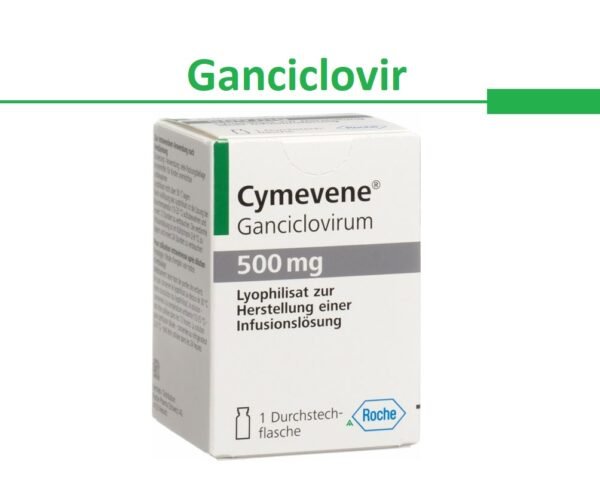Ganciclovir (Ganguard, Cytovene) is an antiviral drug, similar to acyclovir. It inhibits viral replication by incorporating into the viral DNA. It is primarily used in the treatment and prevention of CMV (cytomegalovirus disease) in immunocompromised patients.
Ganciclovir Uses:
-
Prophylaxis of Cytomegalovirus disease in transplant patients:
- It is indicated to prevent cytomegalovirus (CMV) disease in adult transplant recipients at risk for CMV disease.
-
Cytomegalovirus retinitis in immunocompromised patients:
- It is indicated for the treatment of CMV retinitis in patients with AIDS and other immunocompromised adult patients.
-
Off Label Use of Ganciclovir in Adults:
- Cytomegalovirus (CMV) esophagitis or colitis treatment in HIV- positive patients.
- Cytomegalovirus neurological disease in HIV-infected patients.
- Secondary prevention of CMV retinitis in HIV-infected patients
- CMV disease, Preemptive therapy (hematopoietic cell transplant recipients)
- CMV disease, treatment (solid organ transplant recipients)
- Varicella-zoster: Acute retinal necrosis (ARN) in HIV-infected patients
- Varicella-zoster: Progressive outer retinal necrosis (PORN) in HIV-infected patients
Ganciclovir Dose in Adults
Ganciclovir Dose in the treatment of CMV retinitis (immunocompromised patients):
-
Manufacturer's labeling:
- Induction therapy:
- IV: 5 mg/kg/dose every 12 hours for 14 to 21 days followed by maintenance therapy
- Maintenance therapy:
- IV: 5 mg/kg/dose once a day for 7 days/week or
- 6 mg/kg/dose once daily for 5 days/week
- Induction therapy:
-
Alternate dosing:
- Peripheral lesions (alternative agent):
- IV: Induction: 5 mg/kg/dose every 12 hours for 14 to 21 days followed by chronic maintenance (secondary prophylaxis)
- Immediate sight-threatening lesions (adjacent to the optic nerve or fovea):
- Intravitreal injection (off-label route):
- Induction therapy: 2 mg of an extemporaneously prepared solution administered as intravitreal injections for 1 to 4 doses over a period of 7 to 10 days;
- administer with a concomitant systemically administered agent (oral valganciclovir preferred).
- Intravitreal injection (off-label route):
- Peripheral lesions (alternative agent):
Ganciclovir Dose in the treatment of CMV disease prophylaxis in transplant patients: IV:
-
Manufacturer's labeling:
- Induction therapy:
- 5 mg/kg/dose every 12 hours for 7 to 14 days
- Maintenance therapy:
- 5 mg/kg/dose once daily for 7 days/week or 6 mg/kg/dose once daily for 5 days/week;
- The duration of treatment is dependent on clinical condition and degree of immunosuppression.
- Induction therapy:
-
Alternate dosing:
- Hematopoietic cell transplant recipients (allogeneic):
- 5 mg/kg/dose every 12 hours for 5 to 7 days, then 5 mg/kg/dose every 24 hours until day 100 post-transplant.
- Solid organ transplant recipients:
- 5 mg/kg/dose every 24 hours;
- duration of prophylaxis is dependent on the type of transplant, as well as donor and recipient CMV serostatus.
- Hematopoietic cell transplant recipients (allogeneic):
Ganciclovir Dose in the treatment of CMV disease, preemptive therapy (hematopoietic cell transplant recipients) (off-label): IV:
-
<100 days post-transplant:
- 5 mg/kg/dose every 12 hours for 7 days (autologous transplant) or 7 to 14 days (allogeneic transplant), then 5 mg/kg/dose every 24 hours for 1 to 2 weeks or until the indicator test is negative (minimum total induction and maintenance treatment are 2 weeks when 14 days of twice daily is used and 3 weeks when a 7-day induction course is used).
-
>100 days post-transplant:
- 5 mg/kg/dose every 12 hours for 7 to 14 days, then 5 mg/kg/dose every 24 hours for 1 to 2 weeks or until the indicator test is negative.
Ganciclovir Dose in the treatment of CMV disease, (solid organ transplant recipients) (off-label):
- IV: 5 mg/kg/dose every 12 hours until 1 or 2 consecutive undetectable CMV viral load samples are obtained (minimum treatment course: 2 weeks).
-
UL97 mutation for <5x ganciclovir EC50:
- 10 mg/kg/dose every 12 hours.
-
Ganciclovir-resistant strains:
- 5 mg/kg/dose every 24 hours in combination with daily foscarnet and monthly CMV hyper immunoglobulin.
Ganciclovir Dose in the treatment of CMV esophagitis or colitis in HIV-infected patients (off-label):
- IV: 5 mg/kg/dose every 12 hours, then change to oral valganciclovir therapy once oral therapy is tolerated;
- The total duration of therapy: 21 to 42 days or until symptom resolution.
Ganciclovir Dose in the treatment of CMV neurological disease in HIV-infected patients (off-label):
- IV: 5 mg/kg/dose every 12 hours plus foscarnet until symptoms improve.
Ganciclovir Dose as an alternative agent in the treatment of CMV retinitis, chronic maintenance (secondary prophylaxis) in HIV-infected patients (off label):
- IV: 5 mg/kg/dose 5 to 7 times weekly;
- The treatment may be continued until sustained CD4 count >100 cells/mm³ in response to ART for 3 to 6 months; discontinue only after consultation with an ophthalmologist).
Ganciclovir Dose in the treatment of Varicella-zoster: Acute retinal necrosis (ARN) in HIV-infected patients (off-label):
- Intravitreal injection (off-label route):
- 2 mg of an extemporaneously prepared solution administered as an intravitreal injection twice weekly for 1 to 2 doses in combination with IV acyclovir for 10 to 14 days, followed by valacyclovir for 6 weeks.
Ganciclovir Dose in the treatment of Varicella-zoster: Progressive outer retinal necrosis in HIV-infected patients (off-label):
- IV: 5 mg/kg/dose every 12 hours (with or without IV foscarnet) plus intravitreal ganciclovir and/or intravitreal foscarnet.
Ganciclovir Dose in Children
Ganciclovir Dose in the treatment of CMV infection: Limited data available: IV:
-
Congenital Symptomatic CMV or CNS-disease; independent of HIV status:
-
Infants:
- 6 mg/kg/dose every 12 hours for 6 weeks;
- A longer duration of therapy may be considered for HIV positive neonates.
-
-
CNS infection, (HIV-exposed/-positive):
-
Infants and Children:
- 5 mg/kg/dose every 12 hours plus foscarnet;
- continue until symptoms improve, followed by chronic suppressive therapy.
-
-
Disseminated CMV disease and retinitis:
-
Induction therapy:
- Infants ≥3 months and Children:
- 5 mg/kg/dose every 12 hours for 1421 days;
- The dose may be increased to 7.5 mg/kg/dose every 12 hours.
- Infants ≥3 months and Children:
-
Maintenance therapy:
- Infants ≥ 3 months and Children:
- 5 mg/kg/dose as a single daily dose for 5-7 days/week.
- Infants ≥ 3 months and Children:
-
-
Secondary prevention in HIV-exposed/-infected patients:
- Infants and Children:
- 5 mg/kg/dose once a day.
- Infants and Children:
-
Prevention in transplant recipients:
- Children:
- Initial:
- 5 mg/kg/dose every 12 hours for 1-2 weeks,
- followed by
- 5 mg/kg/dose once daily 7 days/week OR
- 6 mg/kg/dose once daily 5 days/week for 100 days
- Initial:
- Children:
-
Prevention in lung/heart-lung transplant patients (CMV-positive donor with CMV-positive recipient):
- Children:
- 6 mg/kg/dose once a day for 28 days
- Children:
-
Other CMV infections:
- Children:
- Initial: 5 mg/kg/dose every 12 hours for 14-21 days;
- maintenance therapy:
- 5 mg/kg/dose once daily for 7 days/week OR
- 6 mg/kg/dose once daily for 5 days/week
- Children:
Ganciclovir Dose in the treatment of Varicella zoster; progressive outer retinal necrosis: Limited data available: IV:
-
Infants, Children, and Adolescents:
- 5 mg/kg/dose every 12 hours plus systemic foscarnet and intravitreal ganciclovir or foscarnet.
Pregnancy Risk Category: N (not defined)
- Ganciclovir crosses the placental barrier.
- [US Boxed Warning] Ganciclovir is known to be a potential cause of birth defects in humans based on data from animals.
- [US Boxed Warning] Ganciclovir could cause temporary or permanent inhibitions of spermatogenesis in males, and suppression of fertility for females. This is based on limited animal data and human data.
- Patients with reproductive potential in females should have their pregnancies tested and be on effective contraception for at least 30 consecutive days.
- Patients who are male should use a barrier contraceptive for at least 90 days following therapy.
Ganciclovir use during breastfeeding:
- It is unknown if breast milk contains ganciclovir.
- The manufacturer does not recommend breastfeeding due to the risk of serious adverse reactions in breastfeeding infants.
- To reduce the risk of HIV transmission, pregnant women with HIV should not breastfeed in the United States.
Ganciclovir Dose in Kidney disease:
Note:
- Renally adjusted dose recommendations are based on an induction dose of 5 mg/kg/dose every 12 hours and a maintenance dose of 5 mg/kg/dose every 24 hours.
-
IV (Induction):
- CrCl ≥70 mL/minute:
- No dosage adjustment is necessary.
- CrCl 50 to 69 mL/minute:
- Administer 2.5 mg/kg/dose every 12 hours
- CrCl 25 to 49 mL/minute:
- Administer 2.5 mg/kg/dose every 24 hours
- CrCl 10 to 24 mL/minute:
- Administer 1.25 mg/kg/dose every 24 hours
- CrCl <10 mL/minute:
- Administer 1.25 mg/kg/dose 3 times/week following hemodialysis.
- CrCl ≥70 mL/minute:
-
IV (Maintenance):
- CrCl ≥70 mL/minute:
- No dosage adjustment is necessary.
- CrCl 50 to 69 mL/minute:
- Administer 2.5 mg/kg/dose every 24 hours
- CrCl 25 to 49 mL/minute:
- Administer 1.25 mg/kg/dose every 24 hours
- CrCl 10 to 24 mL/minute:
- Administer 0.625 mg/kg/dose every 24 hours
- CrCl <10 mL/minute:
- Administer 0.625 mg/kg/dose 3 times/week following hemodialysis.
- Intermittent hemodialysis (IHD) (administer after hemodialysis on dialysis days):
- Dialyzable (50%): IV
- Induction: 1.25 mg/kg every 48 to 72 hours;
- Maintenance: 0.625 mg/kg every 48 to 72 hours.
- Note: Dosing dependent on the assumption of 3 times/week, complete IHD sessions.
- Dialyzable (50%): IV
- Peritoneal dialysis (PD):
- Dose as for CrCl <10 mL/minute.
- Continuous renal replacement therapy (CRRT):
- Drug clearance is highly dependent on the method of renal replacement, filter type, and flow rate.
- Appropriate dosing requires close monitoring of pharmacologic response, signs of adverse reactions due to drug accumulation, as well as drug concentrations in relation to target trough (if appropriate).
- The following are general recommendations only (based on dialysate flow/ultrafiltration rates of 1 to 2 L/hour and minimal residual renal function) and should not supersede clinical judgment: CMV Infection:
- CVVH: IV:
- Induction: 2.5 mg/kg every 24 hours;
- Maintenance: 1.25 mg/kg every 24 hours
- CVVHD/CVVHDF: IV:
- Induction: 2.5 mg/kg every 12 hours;
- Maintenance: 2.5 mg/kg every 24 hours
- CVVH: IV:
- CrCl ≥70 mL/minute:
Dose in Liver disease:
There are no dosage adjustments provided in the manufacturer's labeling (has not been studied).
Common Side Effects of Ganciclovir:
-
Dermatologic:
- Hyperhidrosis
-
Gastrointestinal:
- Diarrhea
- Anorexia
- Vomiting
-
Hematologic & Oncologic:
- Thrombocytopenia
- Leukopenia
- Neutropenia
- Anemia
-
Infection:
- Sepsis
- Infection
-
Ophthalmic:
- Retinal Detachment
-
Renal:
- Increased Serum Creatinine
-
Miscellaneous:
- Fever
Less Common Side Effects Of Ganciclovir:
-
Central Nervous System:
- Chills
- Peripheral Neuropathy
-
Dermatologic:
- Pruritus
-
Infection:
- Catheter Sepsis
-
Local:
- Catheter Infection
- Catheter-Site Reaction
Rare Side effects of Ganciclovir:
-
Cardiovascular:
- Cardiac Arrhythmia
- Chest Pain
- Edema
- Hypertension
- Hypotension
- Phlebitis
- Vasodilatation
-
Central Nervous System:
- Abnormal Dreams
- Abnormality In Thinking
- Agitation
- Anxiety
- Confusion
- Depression
- Dizziness
- Drowsiness
- Fatigue
- Headache
- Hypoesthesia
- Insomnia
- Malaise
- Myasthenia
- Pain
- Paresthesia
- Psychosis
- Seizure
-
Dermatologic:
- Alopecia
- Cellulitis
- Dermatitis
- Skin Rash
- Urticaria
- Xeroderma
-
Endocrine & Metabolic:
- Weight Loss
-
Gastrointestinal:
- Abdominal Distention
- Abdominal Pain
- Aphthous Stomatitis
- Constipation
- Dysgeusia
- Dyspepsia
- Dysphagia
- Eructation
- Flatulence
- Gastrointestinal Perforation
- Nausea
- Oral Candidiasis
- Oral Mucosa Ulcer
- Pancreatitis
- Xerostomia
-
Genitourinary:
- Hematuria
- Urinary Frequency
- Urinary Tract Infection
-
Hematologic & Oncologic:
- Bone Marrow Failure
-
Hepatic:
- Abnormal Hepatic Function Tests
- Increased Serum Alanine Aminotransferase
- Increased Serum Aspartate Aminotransferase
- Increased Serum Alkaline Phosphatase
-
Infection:
- Candidiasis
- Influenza
-
Local:
- Inflammation At Injection Site
-
Neuromuscular & Skeletal:
- Arthralgia
- Asthenia
- Back Pain
- Lower Limb Cramp
- Muscle Spasm
- Myalgia
- Tremor
-
Ophthalmic:
- Conjunctivitis
- Eye Disease (Vitreous Disorder)
- Eye Pain
- Macular Edema
- Visual Impairment
-
Otic:
- Deafness
- Otalgia
- Tinnitus
-
Renal:
- Decreased Creatinine Clearance
- Renal Failure Syndrome
- Renal Function Abnormality
-
Respiratory:
- Cough
- Dyspnea
- Upper Respiratory Tract Infection
-
Miscellaneous:
- Multiorgan Failure
Contraindications to Ganciclovir:
- Allergic reactions to ganciclovir, valganciclovir, acyclovir, or any component of the formulation.
Warnings and precautions
-
Carcinogenic/teratogenic: [US Boxed Warning]:
- Can cause temporary or persistent inhibition of spermatogenesis, suppression of fertility, and birth defects.
- Before starting therapy, females must have a pregnancy test.
- They should also use contraception for treatment for at least 30 days.
- Because of the teratogenic effects of contraception, males should use barrier contraception for treatment for at least 90 days.
-
Hematologic toxicities: [US Boxed Warning]
- Anemia, thrombocytopenia and granulocytopenia (neutropenia) may all occur.
- The majority of neutropenia occurs within the first one to two weeks of treatment, but it can happen at any time.
- Cell counts typically begin to recover within three to seven days after treatment is stopped.
- Patients receiving ganciclovir have had their neutrophil and white blood cells count increase by using colony-stimulating factor.
- Patients with pre-existing Cytopenias or patients who have received myelosuppressive drugs, radiation, or chemotherapy should be cautious.
- Monitor complete blood count, differential and platelet counts frequently in patients with renal impairment or patients with neutrophil counts less than 1,000 cells/mm3 at the start of treatment.
- Ganciclovir is not recommended for patients with an absolute neutrophil count of 500 cells/mm3, hemoglobin >8 g/dL or platelet count below 25,000 cells/mm3.
-
Toxicity in the renal system:
- Increased serum creatinine levels have been reported in elderly patients and transplant patients receiving concomitant nephrotoxic medications (eg, cyclosporine, amphotericin B).
- Monitor renal function, especially for elderly patients or those who are receiving concomitantly nephrotoxic drugs.
-
Renal impairment
- Dosage adjustment is recommended for patients with renal impairment.
Ganciclovir: Drug Interaction
|
Risk Factor C (Monitor therapy) |
|
|
Amphotericin B |
Ganciclovir-Valganciclovir may enhance the nephrotoxic effect of Amphotericin B. |
|
CycloSPORINE (Systemic) |
Ganciclovir-Valganciclovir may enhance the nephrotoxic effect of CycloSPORINE (Systemic). |
|
Didanosine |
Ganciclovir-Valganciclovir may increase the serum concentration of Didanosine. |
|
Mycophenolate |
May increase the serum concentration of Ganciclovir-Valganciclovir. Ganciclovir Valganciclovir may increase the serum concentration of Mycophenolate. |
|
Probenecid |
May increase the serum concentration of Ganciclovir-Valganciclovir. |
|
Tenofovir Products |
May increase the serum concentration of Ganciclovir-Valganciclovir. Ganciclovir-Valganciclovir may increase the serum concentration of Tenofovir Products. |
|
Zidovudine |
Ganciclovir-Valganciclovir may enhance the adverse/toxic effect of Zidovudine. Specifically, hematologic toxicity may be enhanced. |
|
Risk Factor D (Consider therapy modification) |
|
|
Imipenem |
Ganciclovir-Valganciclovir may enhance the adverse/toxic effect of Imipenem. Specifically, the risk of seizures may be increased. Management: Avoid concomitant use of these agents unless the prospective benefits of therapy outweigh the risks. |
|
Risk Factor X (Avoid combination) |
|
|
Cladribine |
Agents that Undergo Intracellular Phosphorylation may diminish the therapeutic effect of Cladribine. |
Monitoring parameters:
- CBC with differential and platelet count at baseline and twice-weekly,
- serum creatinine at baseline and once weekly,
- pregnancy test prior to initiation in females of reproductive potential,
- frequent ophthalmological exams in patients with CMV retinitis.
How to administer Ganciclovir?
IV:
- For intravenous infusion; should not be administered by intramuscular, SubQ, or rapid or bolus IV injection.
- Administer by slow IV infusion over at least one hour.
- A too rapid infusion can cause increased toxicity due to excessive plasma levels.
- Before and after administration flush line with normal saline
Mechanism of action of Ganciclovir:
- Ganciclovir is phosphorylated with a substrate that competitively inhibits DNA polymerase binding to deoxyguanosine triphosphate, resulting in inhibition and inhibition of viral DNA synthesis.
Distribution:
- All tissues, including CSF and ocular tissue, are covered.
Protein binding:
- 1% to 2%
Half-life elimination:
- Neonates 2 to 49 days of age: 2.4 hours
- Children 9 months to 12 years: 2.4 ± 0.7 hours
- Adults: Mean:
- IV: 3.5 ± 0.9 hours;
- Oral: 4.8 ± 0.9 hours;
- CrCl <25 mL/minute: 10.7 ± 5.7 hours
Excretion:
- Through urine (80% to 99% as unchanged drug)
International Brands of Ganciclovir:
- Cytovene
- Ciganclor
- Cymevan
- Cymeven
- Cymevene
- Ganguard
- Ganvir
- Ionops
- Neagel
- Virgan
Ganciclovir brand Names in Pakistan:
Ganciclovir Injection 250 mg in Pakistan |
|
| Gantovir | Graton Pharma |
| Ganvir | Mission Pharmaceuticals |
Ganciclovir Injection 500 mg in Pakistan |
|
| Cymevene | Roche Pakistan Ltd. |
Ganciclovir Capsules 250 mg in Pakistan |
|
| Ganvir | Mission Pharmaceuticals |




